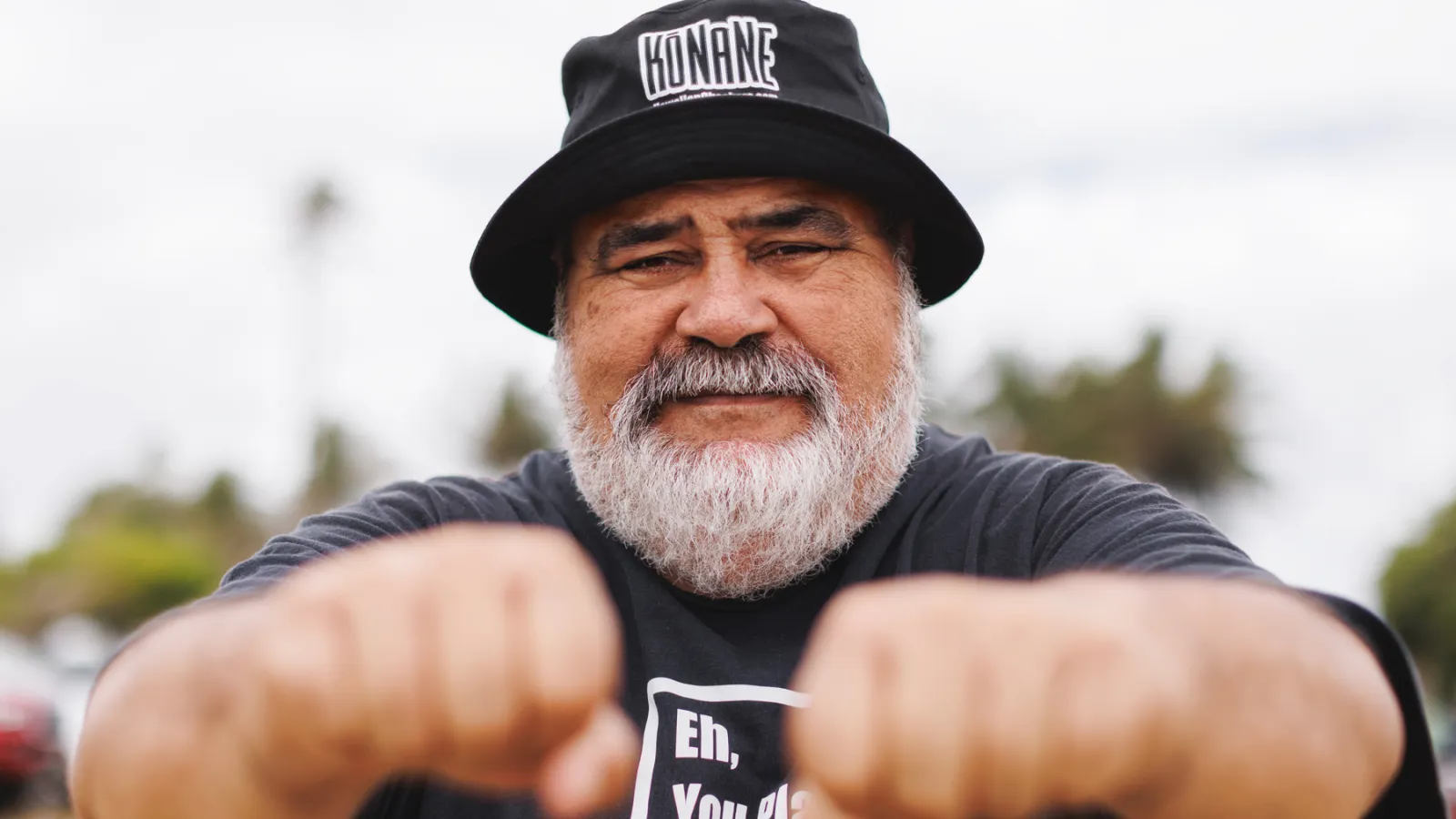
O utside a botanical garden gift shop on the northern shore of the most remote place on earth, rests a reproduction of an ancient board game, chiseled into a block of black stone, its 88 rocks and coral bits resting in 88 divots as if waiting for you to play. A plaque with a cursory description of the game offers a declaration that is equal parts humblebrag and dungeon-master riddle:
“It was said that King Kamehameha the Great was an excellent player who was able to beat his opponent in one move.”
This lore drop about the legendary warrior-chief is a withering tease for Kōnane, a once-ubiquitous pastime that was carved into stone slabs across the islands, some of which still protrude from the ground. You can see them if you look closely among the rocks, the shallow fingerprint-sized holes that make up the game board catching the evanescent breeze along the shore.
This is no easy monument. The American conquerors of Hawaii wanted this game banned.
The disappearance of Kōnane was the penalty for the 1893 U.S. government-backed coup to topple Hawaii’s monarch, Queen Liliʻuokalani. The islands’ new self-proclaimed landlords didn’t just seize land and crops, but further sentenced defining Hawaiian customs to purgatory: dance, music, language. In the crusade to strip the islands to the bones of their humanity, the cultural blacklist included Kōnane.
Buried along with it is a tempting question: How could a board game be so powerful that the most arrogant brutes of the imperialist era wanted it snuffed out of existence? If there’s an answer, it’s on Kaua’i, where I traveled to meet the 65-year-old man trying to bring Kōnane back from the dead.
About two times a month John Kaʻohelauliʻi pops up his makeshift board game workshop at whatever cultural event will take him as a vendor, often several hours early so he can adjust details like the precise angle of his “free lessons” sign. Today in the parking lot of a strip mall behind the Kaua’i Museum he’s arranged four tables topped with his felt-and-marbles version of the Kōnane board — the papamū — and one larger table to sell his custom travel version for $45. There’s nothing in the rules that says a knowledge-keeper can’t also be a pitchman.
Editor’s picks
There’s a women’s health fair being held in the lot today, and Kōnane might appear out of place, but the organizers adore John and his commitment to bring back the game.
In this temporary blacktop universe, airy largo Hawaiian music plays as dancers perform on a stage facing a dozen tented vendors selling plants, clothing, and jewelry — triumphs of the Hawaiian cultural renaissance of the 1970s. A lot has returned — ukulele, hula, woven lauhala hats and bracelets. But not everything has reemerged.
A woman strolls by John’s Kōnane tent.
“Is it like chess?” she asks. It looks a bit like it, after all — a square grid with black and white pieces.
John smiles, holds back. “Totally different game.”
“Checkers?”
Kōnane looks like a mashed-up version of checkers and Go, a grid (John’s are 6×6 but they can be any size) with alternating black and white marbles. To begin the game, John scrambles one of each in a closed fist and lets the woman choose — the same choice that King Kamehameha was said to offer his rivals on the precipice of conflict: black stone for war, white stone for peace. Black goes first, now you jump over a white piece, remove it, and land in an empty space. You play until one player has nowhere to go. It doesn’t matter how many pieces you capture: You win if you make the last move.
Related Content
Kamehameha’s one-move victory won’t be found in these matchups. John lets everyone win; every game they win is a chance they’ll want to play again, maybe right away, maybe later this afternoon. Maybe they’ll buy a set to take home along with a copy of John’s book, Black Book of Kōnane ($15). John loses to a couple in their sixties from Kapaʻa 10 miles north, an 82-year-old woman from nearby in Lihue, a 69-year-old jiu-jitsu practitioner with 14 kids (“I want to learn what I missed”), a couple from North Carolina who takes a set home. Each game ends with John announcing unceremoniously, “and so the game is over.”
With each lesson comes a bit of history. John tells fellow Hawaiians of the wisdom kept in this game like how the stone carvings from hundreds of years ago are believed to have been used as an abacus-esque device for managing and allocating land. Or how the kings and queens of Hawaii played Kōnane with their generals to hone their battle strategy.
The fair is so small (maybe 80 people walk through) it might not clear the bar for a local news writeup, but Kuʻuipo Kumukahi, an award-winning Hawaiian vocalist, has flown in from Oahu to perform lilted songs composed by the folk hero queen Liliʻuokalani and close the fair with a performance of “Hawaii Aloha,” a native hymn. Kumukahi is wearing a red blouse with an overlaid print of the 1897 petition against the annexation by the United States, written by her great-grand-aunt, and signed by 40,000 people. Sometimes when she wears the top, Hawaiians approach her and look for their relatives’ signatures on it.
The protest movement has coursed through Kumukahi’s family. Her father was a road inspector for the state tasked with maintaining a 32-mile stretch on the west end of Hawaii’s Big Island; he used the opportunity to protect ancient feather capes worn by the chiefs of south Kona in hidden caves his grandfather had shown him along the route. When Honolulu’s Bishop Museum got wind of his side-quest, he covered the entrance to the caves with cement with a crew that swore never to reveal their locations. He was forced out of the job.
“It’s the kue – to resist,” Kumukahi says.
Queen Kapiolani, Hawaii’s queen from 1874 to 1891, died on the land that became the site of the elephantine indoor/outdoor Hyatt Regency resort in Waikīkī, where Kumukahi was the cultural ambassador for a decade. During that time she would buy John’s Kōnane sets to introduce them to tourists — until June of 2024 when she was asked to perform at a dinner for a high-ranking American military group.
“The request was, they want to hear the Hawaii story through music,” she said. “And I asked the events department three times: Is this what you want? Are you sure? Because as a Hawaiian, I know Waikīkī. And I’m going to tell you stories of all the royals who lived here, and what they went through. The last one is Queen Liliʻuokalani. She’s in prison. The military comes. They overthrow her, an illegal overthrow. And then while she’s in prison, she’s writing songs.”
These are the songs Kumukahi performed for the U.S. military group. Two weeks later, she says, the Hyatt general manager told her the group refused to pay their bill — they didn’t like what they’d heard. If she wanted to continue as cultural envoy, the manager said, she was no longer allowed to work with the nonprofit she had partnered with, the Hawaiian Music Perpetuation Society. Instead, she quit. These days, she gets paid to perform those same songs three days a week for tourists in Honolulu’s Iolani Palace in the imprisonment room where Queen Liliʻuokalani was jailed 130 years ago.
“They don’t want to learn,” Kumukahi said. “They live in a bubble.”
“I do forgive them for what they’ve done,” she said
Tulu Mana, an administrator with the music nonprofit, said: “If I’m dealing with people in Waikiki or different hotels… you have to give and take and stuff like that, understand you have to let them jump you.”
“Pick your battles kind of thing,” she said. “It’s the Kōnane game.”
SMITH’S FERN GROTTO TOURS ON THE eastern shore of Kauaʻi is a riverfront pavilion with two cubicle-sized offices, a family-owned boat ride business providing 90-minute trips down the Wailua River, and the site where John says he discovered his kuleana — his purpose, or responsibility — to spread the Kōnane gospel. Working like 47,000 other Hawaiians in the euphemistically exceptional hospitality and tourism industry, John was a tour-bus driver whose route stopped at Smith’s. At a handful of red picnic tables between the two offices, John, according to his telling, would play cards with a half-dozen other bus drivers waiting for the boats to return from the river cruise. One day in 2000, John fished out from his garage an old Kōnane board that he had bought for his kids. The other drivers latched on — it was Hawaiian, vaguely familiar, and unlike cards, the game didn’t blow away. Life had new meaning.
The red picnic tables have since been repainted green. Momi Kapana, a daughter of the Smith family enterprise who now also administers marriage licenses from the same office, worked there when John had his revelation.
“I just remember him coming and sitting here with his Kōnane board thing with his Kōnane pieces,” she said, minutes before issuing a marriage license. But it was interesting to her — Kōnane? Here? She says, “Nobody does it anymore.”
Inside a pavilion built for shelter after Hurricane Iniki struck Kauaʻi in 1992, with paintings of dolphins and waves on the walls, John runs a brief tournament for eight players before a community movie night in Anahola, a homestead neighborhood reserved for Hawaiians. “Movie night” is lightly euphemistic — once the sun sets, lawn chairs will be set up in the outfield facing an inflatable projector screen that will show a few YouTube videos about Hawaiian backyard music and cultural storytelling.
John’s efforts to reseed Kōnane across Kauaʻi are modest but steady. Since starting his crusade he’s reintroduced the game at dance events, food festivals, prisons, and classrooms in the Kamehameha school system (named after the great warrior-chief and fabled one-move Kōnane champion). He inspired Ivory Lloyd, the mother of two kids, to run a Kōnane club at their school.
“There’s a lot of things in the Hawaiian culture that people are scared if they don’t do it correctly, that they’re not Hawaiian enough,” Lloyd said. “That is one of the beauties of having the kids do it.”
There’s little pomp to the tournament in the pavilion, and it’s unobtrusive to the other activities unfolding on the other picnic tables like bracelet weaving and taro planting. John explains the rules to the first-timers, and the bracket begins — four matches at once.
John describes Kōnane’s structure in three parts: a beginning game, where opening moves determine the shape of the board; the middle game, where mistakes can be afforded and compensated for; and the endgame, where every move can make or break the result. These subdivisions are crossed not by timer or physical marker but by feeling. When you’re in the endgame, you just know it.
The final tournament match is between Kauila, a teenager John admires for his steady gameplay, and Felix, a newcomer. In the endgame of their 10-minute match, Kauila forgets what color he is — oddly, a mistake so common that John sells black and white beaded bracelets ($5) to wear to remind players which stones are theirs. Felix pulls off the upset. But John isn’t surprised.
“He’s been known to throw the game,” John says, recalling a match where Kauila played a cute girl and held back.
“Sometimes when you lose, you actually win,” he says.
FORBES ESTIMATES THAT 37 MEGARICH people own 11 percent of all privately owned land across Hawaii. Of the 37, six of them are on Kauaʻi, an island you can drive around in two hours without traffic.
The island is a playful, nonthreatening wilderness where chickens and roosters gallop along roads as if they have their own HOV lane.
On the south shore you can see remnants of the once-profitable sugar plantation now home to the Koloa Zipline — even the old rails that carried sugar by train now run literally into Building 11 of the Marriott Autograph Collection Koloa Landing Resort (voted best pool in America five years in a row by USA Today), where the resort manager, Tim Albao, whose ancestors came to Hawaii on a boat to spread the gospel on the sugar plantation, is currently working sugar as a “theme” into the hotel. It’s also where the concierge, Kiana Ka’ahanui, remembers encountering Kōnane for the first time at the Anahola homestead pavilion a decade or so ago, seeing John play the game missionaries tried to strike from history.
“They wanted to wipe it out,” she says.
In John’s book, he writes: “Every time a Hawaiian passes up a chance to play Kōnane, it is another victory for those who took it away.”
The northern shore is an agrarian Eden clogged with the rental cars of honeymooners, mainland families and other tourists on an Instagram spree. In wealthy pockets, Babylonic trees planted in perfect lines draw your eye up and away from the tar-colored skins of frogs pancaked by SUVs. Sandy hideaways snatched up by millionaires are freckled with the most ironic “no trespassing” signs on the globe. Do you think if the missionaries arriving in 1820 saw a “keep out” sign on Moloa’a beach they would have turned around?
Despite being a resort manager of one of the nicest hotels in Hawaii, Albao said the only chance he’ll have of owning land is if his mother, Liberta, the president of a civic association, is selected for a homestead property. He recalled recently working on his boss’s computer when an email popped up with a new housing listing, and he recognized the estate.
“I was like, ‘Dude, that’s my next door neighbor — click on that,’” he said. The price was $1.195 million. “A lot of the workers that work here don’t necessarily make the means to afford that kind of stuff… How is an industry like this going to sustain itself if you don’t let the people service the guests because they don’t have nowhere to live?”
The spirits of Zuckerberg, Frank VanderSloot, Pierre Omidyar and the rest haunt the island for Liberta and plenty of others. She has one request for me: “Can you take them home with you?”
John stands on a small road shoulder overlooking the Menehune fishpond and boasts of its wisdom: The rock wall built down the middle 600 years ago with a tiny sluice allowing small fish to pass through, then fatten up with food until they’re too big to fit through the gate back into the river. Trapped by ancient technology. Unable to make their last move.
By the way, even this natural memorial of ancient Hawaiians’ ecological wonder can’t escape the living ghost of Zuckerberg — he donated $4 million (0.0016 percent of his wealth) to preserve it and scrape a notch in the good PR column. But now the land won’t be turned into condos, and kids can come learn about how a civilization here hundreds of years ago figured out how to fish more efficiently than anyone else in the world.
“The ingenuity that you need to come up with these creative solutions to challenges probably all came off of the papamū and the playing of Kōnane, developing those critical thinking skills,” John says.
When you see the world through Kōnane, everything is Kōnane. Asked if he has interest in learning the original Hawaiian language — a key vestige of Hawaiian culture that’s making a comeback — John hesitated. Its complexity and the time commitment required… he compressed the decision to a choice between that and the other things he needs to do in his life.
“You have to choose,” he said. Then he held out his hands, fists closed, over the fishpond as if he was starting a Kōnane game. “Black or white.”
When John’s mother needed hospice care, he and his sister had to decide whether to move her close to them on Kauaʻi, a rural island where dozens of movies have been filmed but which lacks so much as a movie theater, or keep her on Oahu, which has better medical care. They chose to keep her there.
Across the highway from a resort-town shopping center on the north shore is a sign reading simply, “Scenic Overlook.” But at the bottom of the mountains is another display of ancient knowledge: the taro fields, an unfolding tapestry of Hawaii’s most abundant crop, arranged in perfectly manicured rectangular patches wet and dry, the exact amount of water measured meticulously to guide the starchy root vegetable on its 12-month journey to fruition. Elders pass on the story that Hawaiians placed rocks in the mountain’s waterfalls to control the flow and temperature that seeped into the taro pools hundreds of feet below. Look at the picturesque grid formed by the taro patches, John said when he sent me here — that’s the papamū. That’s Kōnane.
That’s Kōnane?
Tourists from Nevada and Chicago and Phoenix pull over to log selfies of the mountain-to-taro landscape, unenlightened to this tasty bite of agricultural canon that puts the phrase “resource management game” to shame. Catan and Everdell and every other commodity based board-game-of-the-year winner are mere simulations of the process of gathering and spending resources to replicate the time-lapsed sensation of building a city-state. Kōnane cackles with the frayed voice of a centuries-old elder. This is no simulation.
John’s theory — that the agrarian plots of Hawaii’s prized plant is the physical representation of a game board — is the idea that life itself sprung into abundance because of play. Did the ancients here really see power in a game that could be leveraged in ways that no other game ever could?
Two milestones happen for a person when they play a game — any game — for the first time. The first is when they’ve had enough of hearing the rules and want to get going already. The three words they always say when this moment arrives are, “Let’s just play.”
The second is subtler but more satisfying to watch: It’s when their face says, “I get it.” This happens at different points for everyone and for every different game — starting your army in Australia prevents you from being attacked in two directions; spending one turn connecting a six-train route from Houston to El Paso is worth more points and more efficient than using smaller routes; just because my hand has no hearts doesn’t mean someone won’t slip one into the trick for me to win with another suit. Getting the game is when the brain goes “next time we play I’m doing things differently” and it almost always leads to the other words that happen at the end of a great game: “Let’s play one more.”
There are plenty of cultish game-night pamphlet loglines about play: It feeds our inner child suppressed by a world of stress and seriousness, it lets us create and change by prying our minds open to paths we didn’t see before.But the thing about play that feels essential at this point in history is that autocrats hate play. In its most collaborative form, play makes us braver and bolder. There’s a reason you don’t hear about Vladimir Putin locking into Gloomhaven or why Mark Zuckerberg’s employees always let him win when they played Catan.
AFTER SPENDING THREE DAYS with John I discovered that the line between his play and his business is fuzzier than I thought. He’s always on brand — when he pops up his tent he hangs a banner and wears a T-shirt that both ask, in comic sans, “Eh, you play Kōnane?”, along with a simple “Kōnane” hat. It’s not a bad thing. Do what you have to do to get people to play.
On our last day together we unfolded a card table on the beach near his home in the Anahola homestead to finally play. He took out an 8×9 wooden board for a longer and more complicated match (so he could practice for a tournament on Oahu using that size). As an unexpected warm-up game, John asked an Australian passerby to play me while he watched.
Belinda Gerard and I played one game for an hour, our splintered reflections staring back at us in John’s 72 shiny marbles like they were a fly’s eyes. She’d never played before, and she recycled her early mistakes into comeback moves efficiently. She was patient, sometimes taking four minutes to make a move. Twenty minutes in I stupidly broke ranks on a back line and John pounced on it.
“I think that might have been the mistake that might come back to bite you,” he said.
She triple-jumped me — a feat I hadn’t seen on the smaller boards we’d been using until now — and even for a first-time player it was a surgical process to cut me off from resources for the rest of the game. I knew the words were coming…
“And then the game is over.”
John was delighted. “Let me take a picture of you making the winning move,” he said to her.
Rattled from the loss I carried my defeat into a series of games with John in which he suspended his let-them-win rule. Grasping for a silver lining I told myself it felt good to lose in a spot where Kamehameha might have played, might have beat someone in one move, however that’s possible.
I bought one of John’s boards and told him something’s been stuck in my head — the taro fields. The idea that a board game could inspire agriculture was tickling my imagination. There’s limited written record of pre-colonized Hawaii, making this claim difficult to confirm. I asked John if it would be OK if I tried to ask a taro farmer about the theory.
“They might be like ‘Who’s this guy coming over here,’” he said. “If anything, you’ll get some good pictures.”
I’M DRIVING TO THE END.
Along a dirt road off the narrow highway that hugs the northern shore the taro leaves extend like waving hands from the quilt of rectangular pools so shallow that the birds in them stand with their leg joints exposed. The homes here are not the homes of Hawaiian relocation fantasies: Machinery, clumps of cars, sheds and John Deere vehicles crowd overgrown lawns. One of these simple box homes doesn’t appear to have a readily visible door I can even knock on.
All of them have a visibly displayed message: “No Trespassing.”
One by one, the farmers who bother to acknowledge me decline to speak and ask me to leave.
Deeper down the road the slap of the drooping tropical tree branches against the windshield are like punishing whacks to the face for trying to force a metaphor. An abandoned SUV with vines growing in the tires is basically saying “turn around.” Maybe a game is just a game.
The road bends slightly and suddenly the space opens up, revealing a vast property with a mowed lawn, paved driveway and tall basketball hoop, and bonsai garden in the back.
As I walk down the driveway a 70-year-old woman dressed casually in a white T-shirt walks out. I tell her I’m writing about Kōnane.
“The board game?” she says. “Do you want to come in and sit?”
I tell her John’s theory, that the taro farms are based on the Kōnane board. She’s not sure about it — she’s not a taro farmer, and hasn’t played Kōnane in decades — but says the hypothesis is possible. She can text people who might know: a couple of executive directors involved in protecting the environment on the northern shore.
It turns out that I’ve driven onto the property of former Hawaii State Representative Mina Morita.
She moved out here 45 years ago to live with her husband in seclusion in a taro shack (since destroyed by hurricane and rebuilt), away from rising home prices, but my thirst to prove a narrative led me to find her anyway. Her connection to taro is not just proximate — she dedicated part of her career to bringing water to the taro farmers in her district.
These taro farms by her house were converted during the gold rush to rice paddies to ship rice to California, then back to taro and have stayed that way since — except for a small section that was reconverted to rice for the 2008 film Tropic Thunder because they needed it to look like Vietnam.
While I wait for the experts to help me confirm John’s theory, I figure I might as well get a top-down view from the trail nearby.
Two miles back toward the highway I pull off into the Okolehao trailhead. From the summit I’ll be able to see the taro fields splayed out into the horizon. Rummaging through the backseat for my hiking gear I turn over my sweatshirt and reveal the Kōnane board I had bought from John that morning.
What was I thinking?
When Morita picks up on the first ring, I say, “This is going to sound a little weird, but… Do you want to play a game of Kōnane?”
Morita’s referrals led me to Kawika Winter, an ecologist at the University of Hawaii and a self-described “ecotone” of Hawaiian culture — a native who translates passed-down stories of elders and filters them through the scientific process. And he has an answer for me: John’s theory is wrong.
The modern taro fields, he says, look nothing like ancient taro production, which was made up of smaller patches that bore no resemblance to the papamū. But…
“Did John say that the taro fields were laid out as the konane board,” he said, “or did you imagine that as he was talking and then go search it out?”
“Even though we talk in English, sometimes we’re thinking Hawaiian,” he says.
Basically I misinterpreted John and took his words as a rumor to chase down like a caricature of an ACME reporter acting on a hot tip.
“He told you, ‘There’s a Kōnane board,’” Winter said. “He sees a flow of energy, nutrients, labor. It’s like he just looks and it’s all right there. It’s like the matrix. He sees all the things coming down and all you see is green numbers.”
When you see the world through Kōnane, everything is Kōnane.
One riddle busted, but another remained unsolved: King Kamehameha and the one-move win. Winter happens to be the perfect person to run this one by — he’s the guy who chiseled the papamū outside the Limahuli Gardens gift shop and wrote the sign with the puzzler that dogged me all around Kauaʻi. (Plus, Winter is actually friends with Kamehameha — at least, the Hawaiian actor portraying him in an Apple TV series starring Jason Momoa.)
“If you’re thinking in a Hawaiian way, what that means is Kamehameha was undefeated at Kōnane,” he said. “Like nobody could ever beat him. What it means is if he sat down and he made a move, you already lost, because he’s undefeatable.”
And now, finally, I get it.
As John says in his book: “The only way you can lose in Kōnane is not to play.”
The board I bought from John unfolds on the dining room table before former state representative Mina Morita and it all starts coming back to her.
“It’s just been such a long time,” she says.
Her mind reaches back a half-century: She’s in eighth grade, in a class called “industrial arts,” in which she carved out the holes in a Kōnane board — made the divots and sanded them down. Collected the coral from the beach to use as pieces and colored stones with a black sand mixture.
I hold out my fists, and she picks black.
She makes her first move.
For 20 minutes we play on the 6×6 grid, talking about public utility work on the island, studying the water levels and the impact of cesspools and septic tanks, workforce housing, the degradation of local news. At times we won’t talk at all. For two or three minutes we’ll sit in silence and play. She’ll study the board, considering her moves, then jump over my piece.
We’re hopping over each other’s marbles in this game once used for land allocation while we’re talking about Mark Zuckerberg amassing his Kauaʻi compound through a technically legal practice of buying plots when property owners died and their land went into probate — a period of time when Hawaiians can make a claim to the area to show they are the rightful heir.
“They quit claiming the property and so he paid off everybody that responded,” she says.
After some time the board has more empty slots than pieces.
“Now I really have an appreciation for hotels,” she says. “Go to a hotel, stay there, we’ll treat you really good.”
“Come and visit,” she says. “But don’t stay here.”
There are only a handful of moves left. When you’re in the endgame, you just know it.
I’ve been watching the island’s Kōnane master play for three days, and she hasn’t played in 50 years.
“Oh no, you’ve got lots of moves,” she says. “I’m stuck.”
I hear John’s voice in my head: And so the game is over.
She laughs. “I was trying to play defensively.”
“Really good game,” I say. I start to pack up, when former state representative Mina Morita says the words I was hoping for:
Trending Stories
“One more, one more,” she says.
“Two out of three.”



